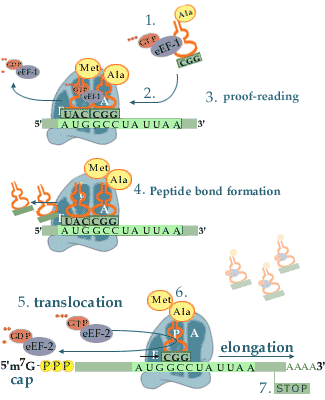Elongation
Elongation is the stepwise
addition of amino acids to the growing protein chain.
The order of amino acids is specified by the sequence
of codons in the mRNA,
see the genetic
code».
Protein factors, eEFs (eukaryotic elongation
factors), are necessary to speed up the elongation
cycle. The elongation process proceeds in the
following order:
1. Amino acid-containing tRNA
molecules (aminoacyl-tRNAs, aa-tRNA)
are picked up by elongation factor eEF-1 in the
presence of GTP.
2. The formed complex enters the empty A-site on a
ribosome carrying an initiator Met-tRNAi
or a peptidyl-tRNA.
3. On the ribosome, the anticodon of the incoming
aminoacyl-tRNA is matched against the mRNA codon
positioned in the A-site. As
the three bases in the codon can be arranged in 64
different combinations, the translational machinery
must be able to select the aminoacyl-tRNA carrying
the matching anticodon. During this proof-reading,
aminoacyl-tRNAs with non-cognate anticodons are
thrown out of the ribosome and replaced by new
aa-tRNAs that are to be checked.
4. When the right aminoacyl-tRNA enters the A-site
the growing polypeptide in the P-site is almost immediately linked to
the new amino acid in the A-site via a peptide bond. Formation of
the peptide bond is catalysed by the ribosome itself.
The reaction leaves an empty tRNA in the ribosomal
P-site and the new peptidyl-tRNA in the A-site.
5. In the next step the ribosome moves one codon
forward on the mRNA. Simultaneously, the empty tRNA
is displaced from the P-site to the E-site as the peptidyl tRNA is
translocated from the A-site to the P-site. The
process is facilitated by elongation factor eEF-2 and
GTP.
6. After the translocation, the peptidyl-tRNA is
positioned in the P-site and the next codon on the
mRNA is made available for interaction with a new
aminaoacyl-tRNA in the A-site.
7. These reaction steps are repeated until the
ribosome encounters an in-frame stop-codon. At this
point the translation is terminated.
|
